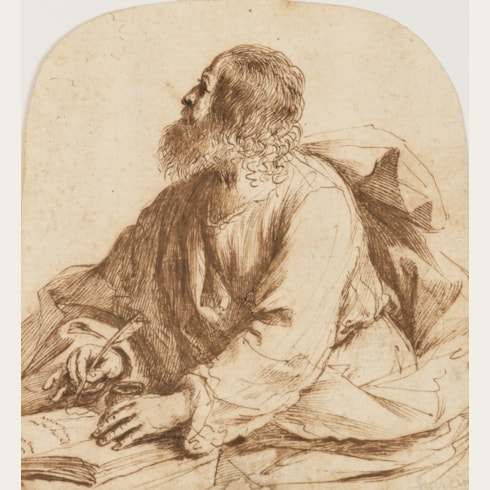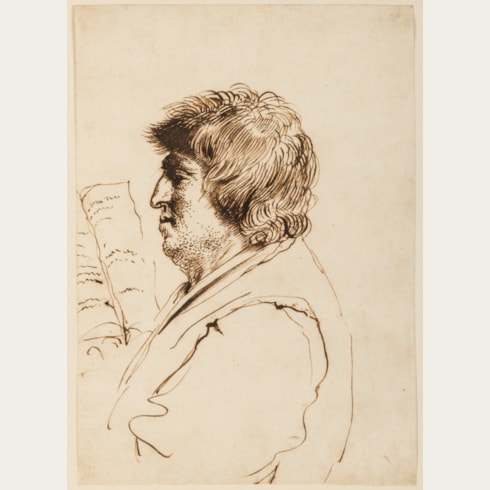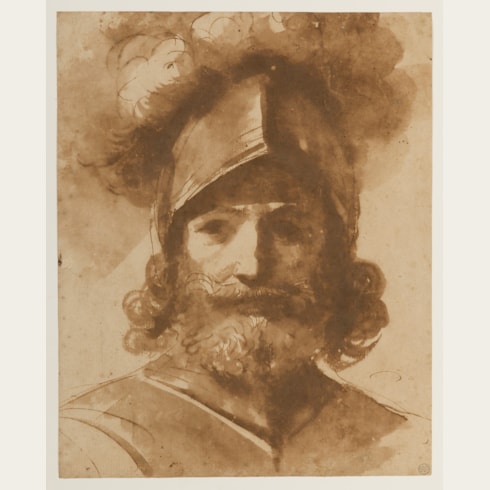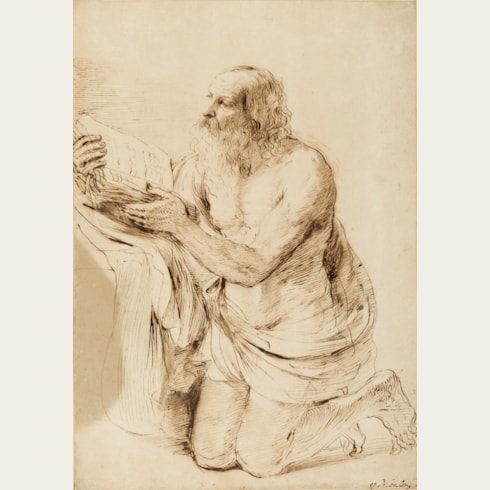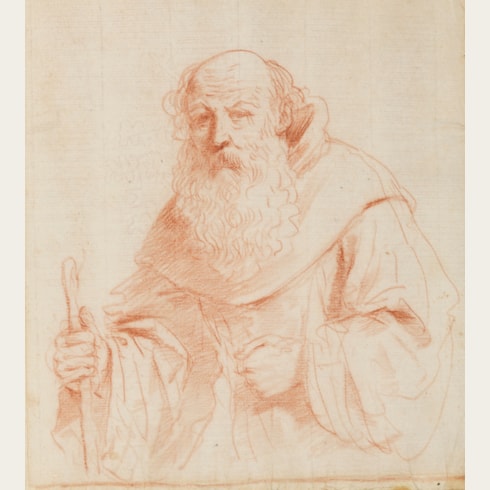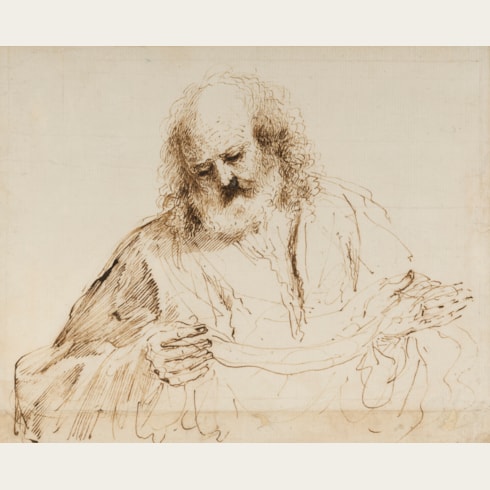Giovanni Francesco Barbieri GUERCINO
(Cento 1591 - Bologna 1666)
A Woman with a Vase of Flowers (Flora?)
Inscribed (by Milford) Guercino and numbered No. / 495. on the old backing sheet.
257 x 182 mm. (10 1/8 x 7 1/8 in.)
A stylistic and thematic connection may be made with a pen and ink drawing by Guercino of a Seated Woman Wearing a Wreath of Foliage on her Head, in the Royal Collection at Windsor Castle, which has been tentatively related to a lost Flora painting of 1632.
An 18th century etching by Francesco Romero, after a lost drawing by or attributed to Guercino, depicts an analogous subject of a woman with a vase of flowers. Also similar in style and subject is another print, after a lost Guercino drawing of a woman holding a flower in her upraised left hand, by James (Giacomo) Nevey, a Scottish painter and engraver resident in Rome, which was one of a series of etchings after drawings by Guercino published by Giambattista Piranesi in 1764 as 'Raccolta di Alcuni Disegni del Barberi da Cento detto Il Guercino'.
The present sheet was part of the collection of drawings assembled by the 18th century British politician Sir Erasmus Philipps FRS, 5th Baronet (1699-1743), which remained in the possession of the Philipps family until the 1940s, when it was dispersed. The majority of the drawings - mostly Flemish, Dutch and Italian sheets of fine quality - are thought to have been part of a 17th century Italian collection and to have been acquired by Erasmus Philipps in Italy in the late 1730s or early 1740s.
Giovanni Francesco Barbieri, known as Il Guercino (‘the squinter’) because he was cross-eyed, was by the second decade of the 17th century one of the leading painters in the province of Emilia. Born in Cento, a small town between Bologna and Ferrara, Guercino was largely self-taught, although his early work was strongly influenced by the paintings of Ludovico Carracci. In 1617 he was summoned to Bologna by Alessandro Ludovisi, the Cardinal Archbishop of Bologna, and there painted a number of important altarpieces, typified by the Saint William Receiving the Monastic Habit, painted in 1620 and now in the Pinacoteca Nazionale in Bologna. When Ludovisi was elected Pope Gregory XV in 1621, Guercino was summoned to Rome to work for the pontiff and his nephew, Cardinal Ludovico Ludovisi. It was in Rome that Guercino painted some of his most celebrated works, notably the ceiling fresco of Aurora in the Casino Ludovisi and the large altarpiece of The Burial and Reception into Heaven of Saint Petronilla for an altar in Saint Peter’s. The papacy of Gregory XV was short-lived, however, and on the death of the Pope in 1623 Guercino returned to his native Cento. He remained working in Cento for twenty years, though he continued to receive commissions from patrons throughout Italy and beyond, and turned down offers of employment at the royal courts in London and Paris. Following the death of Guido Reni in 1642, Guercino moved his studio to Bologna, where he received commissions for religious pictures of the sort that Reni had specialized in, and soon inherited his position as the leading painter in the city.
Guercino was among the most prolific draughtsmen of the 17th century in Italy, and his preferred medium was pen and brown ink, although he also worked in red chalk, black chalk, and charcoal. He appears to have assiduously kept his drawings throughout his long career, and to have only parted with a few of them. Indeed, more drawings by him survive today than by any other Italian artist of the period. On his death in 1666 all of the numerous surviving sheets in his studio passed to his nephews and heirs, the painters Benedetto and Cesare Gennari, known as the ‘Casa Gennari’.
The drawings of Guercino, which include figural and compositional studies, landscapes, caricatures and genre scenes, have always been coveted by later collectors and connoisseurs. Indeed, the 18th century amateur Pierre-Jean Mariette noted of the artist that ‘Ce peintre a outre cela une plume tout-à-faite séduisante’. The largest extant group of drawings by Guercino is today in the Royal Collection at Windsor Castle; these were acquired from the Gennari family by King George III’s librarian, Richard Dalton, between about 1758 and 1764.
Provenance
By descent to Richard Philipps, 1st Baron Milford, Picton Castle, Pembrokeshire (Lugt 2687), with his label and number 'No.495' on the back of the old mount
By descent to Sir John Erasmus Gwynne Alexander Philipps, Bt., Picton Castle, Pembrokeshire, until 1943 or 1946
Probably acquired from him by Hans Calmann, London
Anonymous sale, London, Sotheby’s, 28 March 1968, lot 42 (‘Il Guercino, A Young Lady arranging flowers in a vase, pen and brown ink, framed c. 250mm x 180mm. From the Milford Collection (L. 2687)’)
Herman Shickman, London, in c.1972
Joseph Goldyne, San Francisco
Private collection, San Francisco.
Literature




















